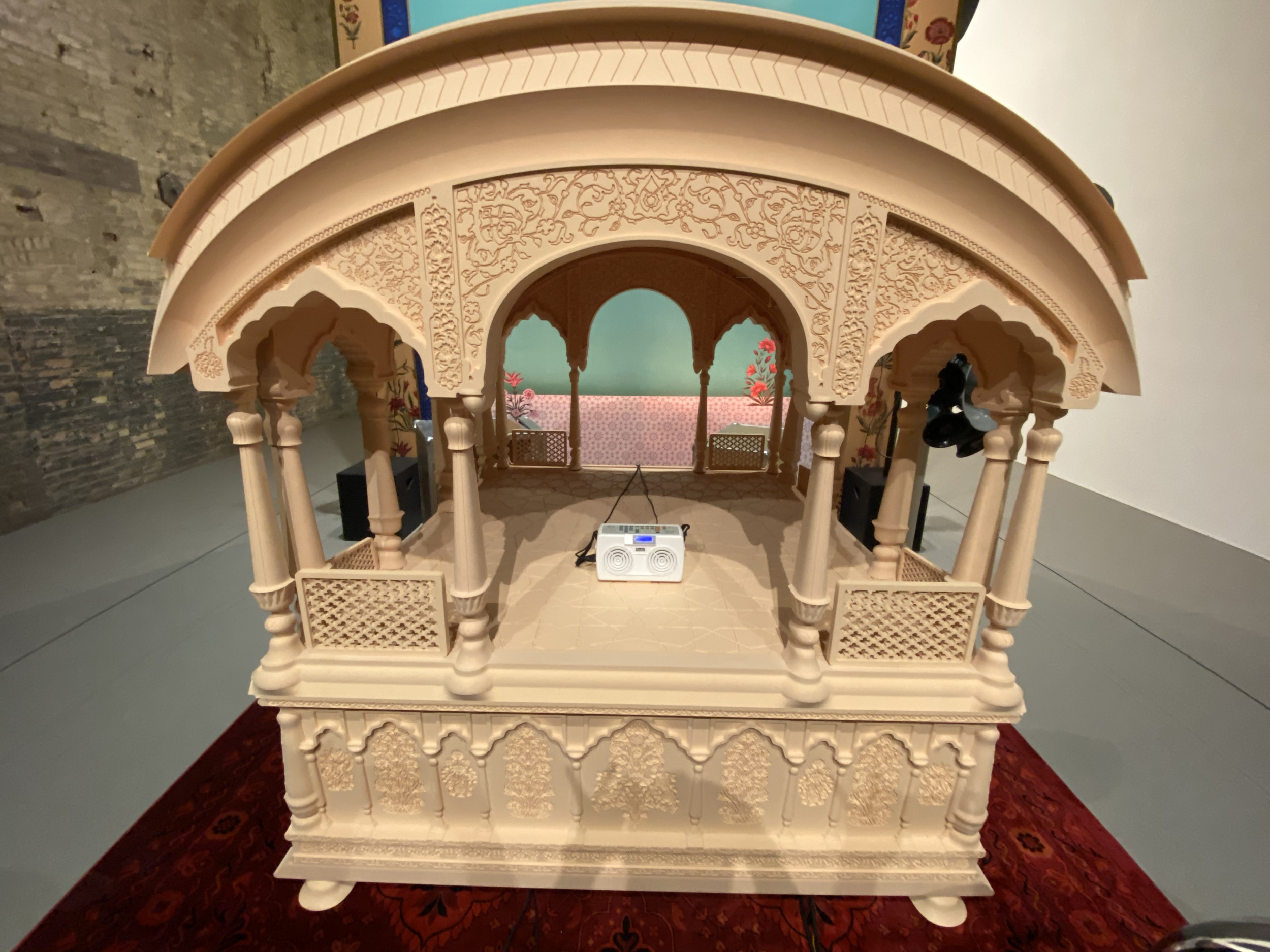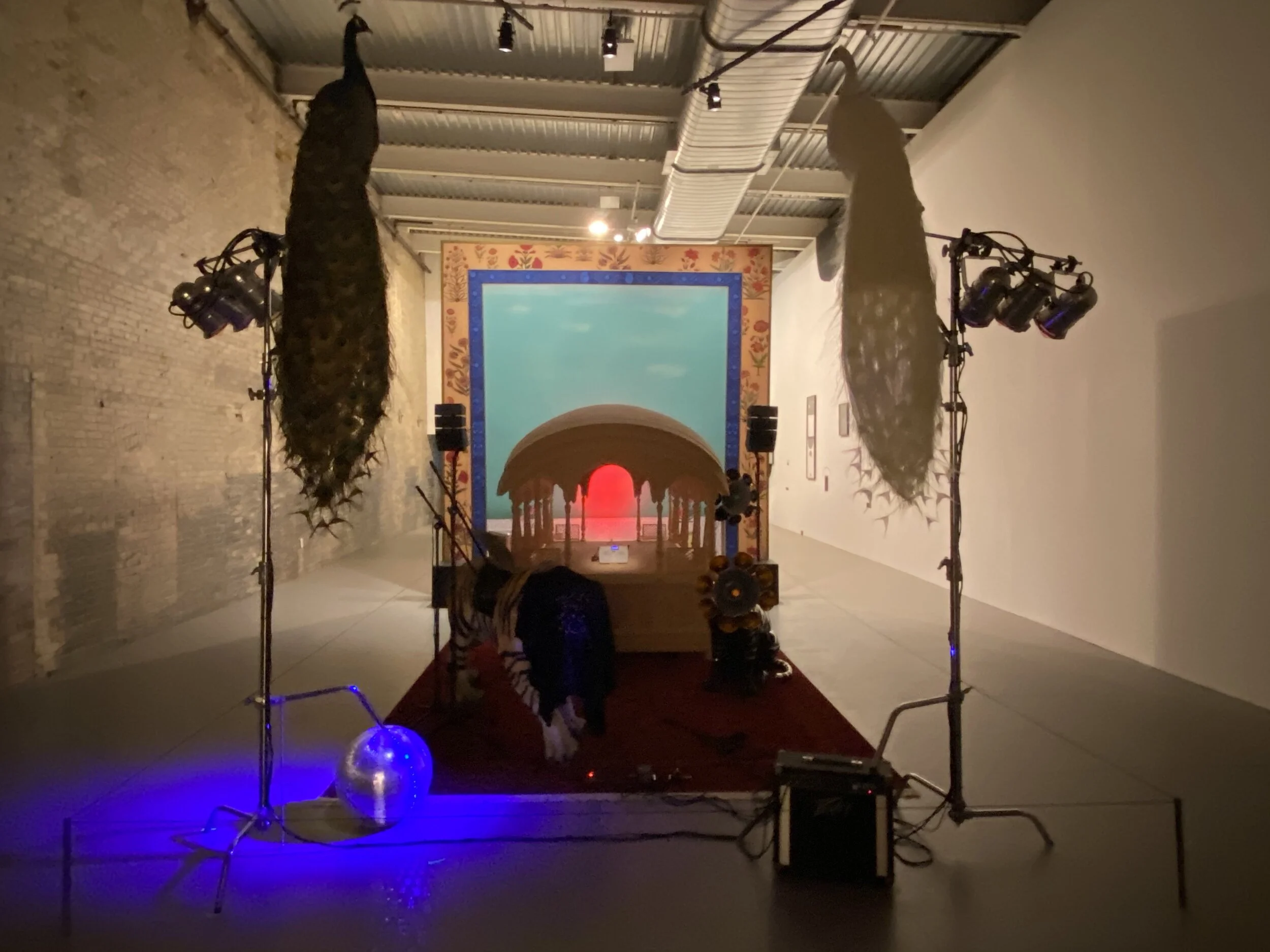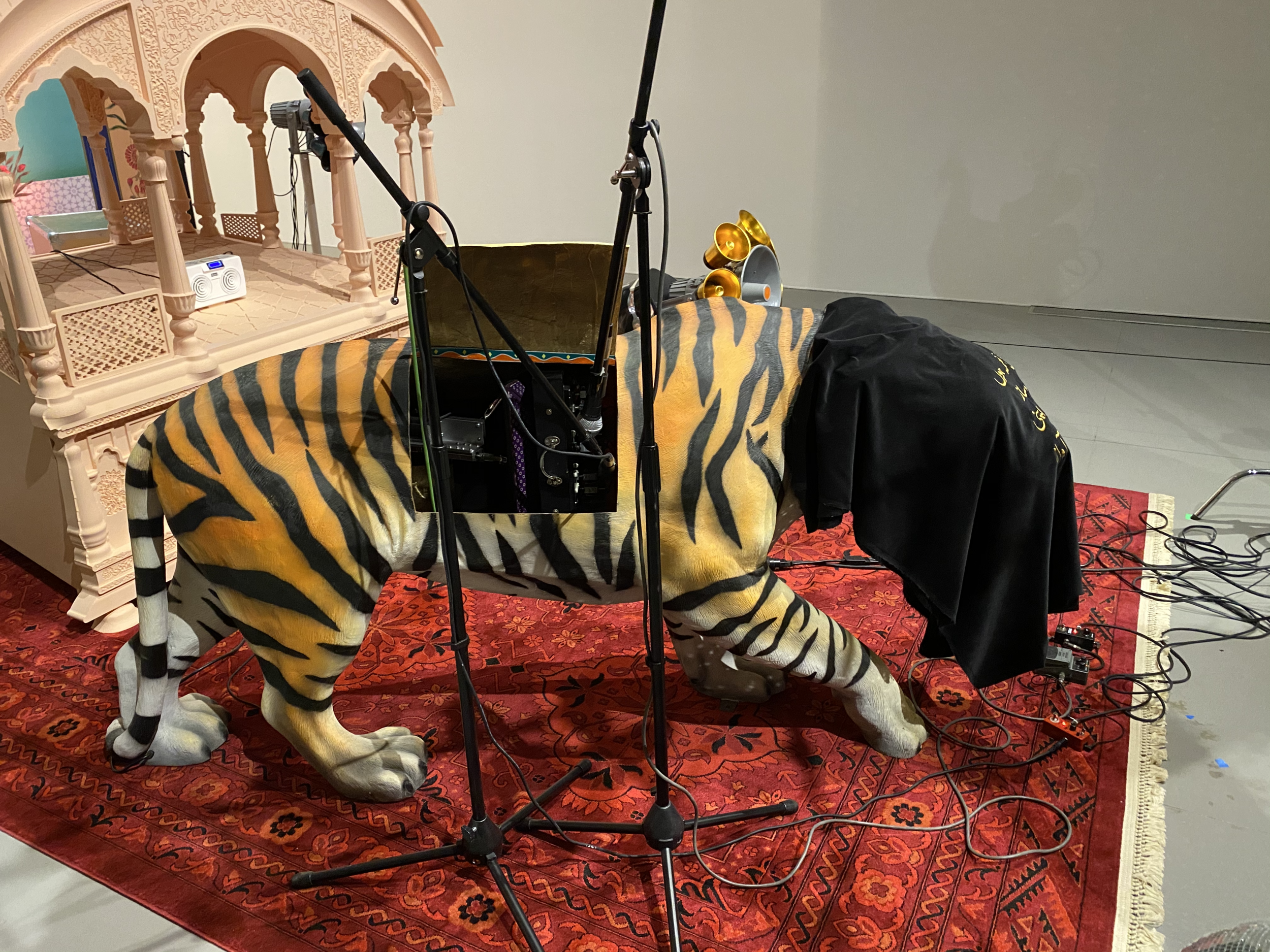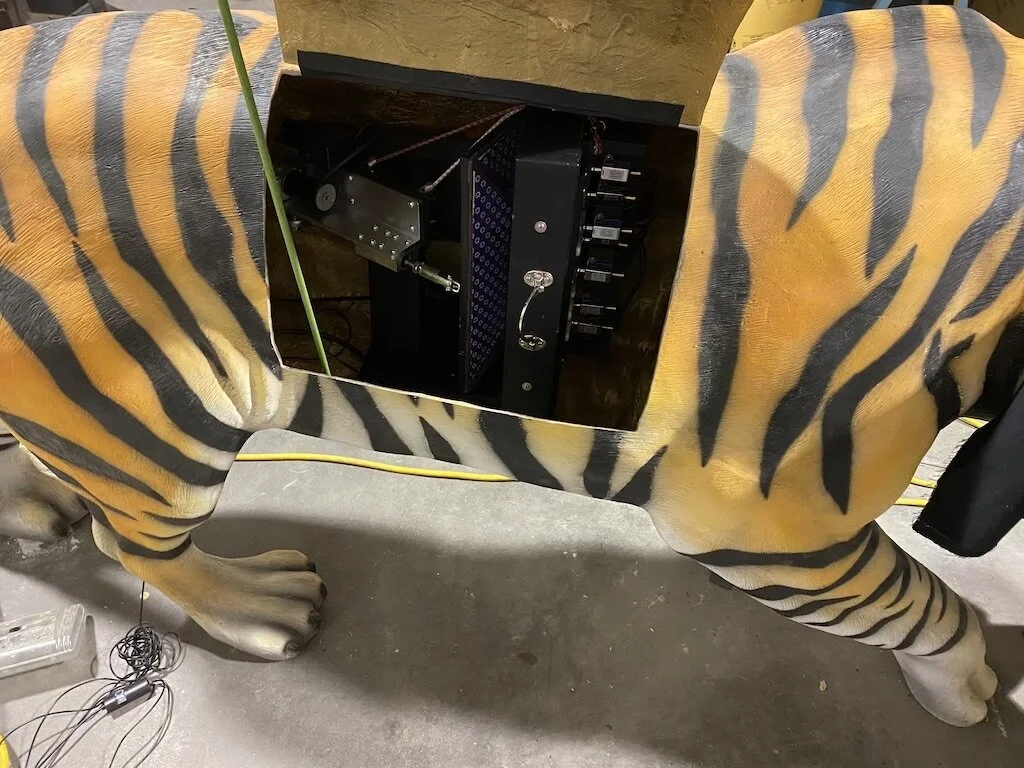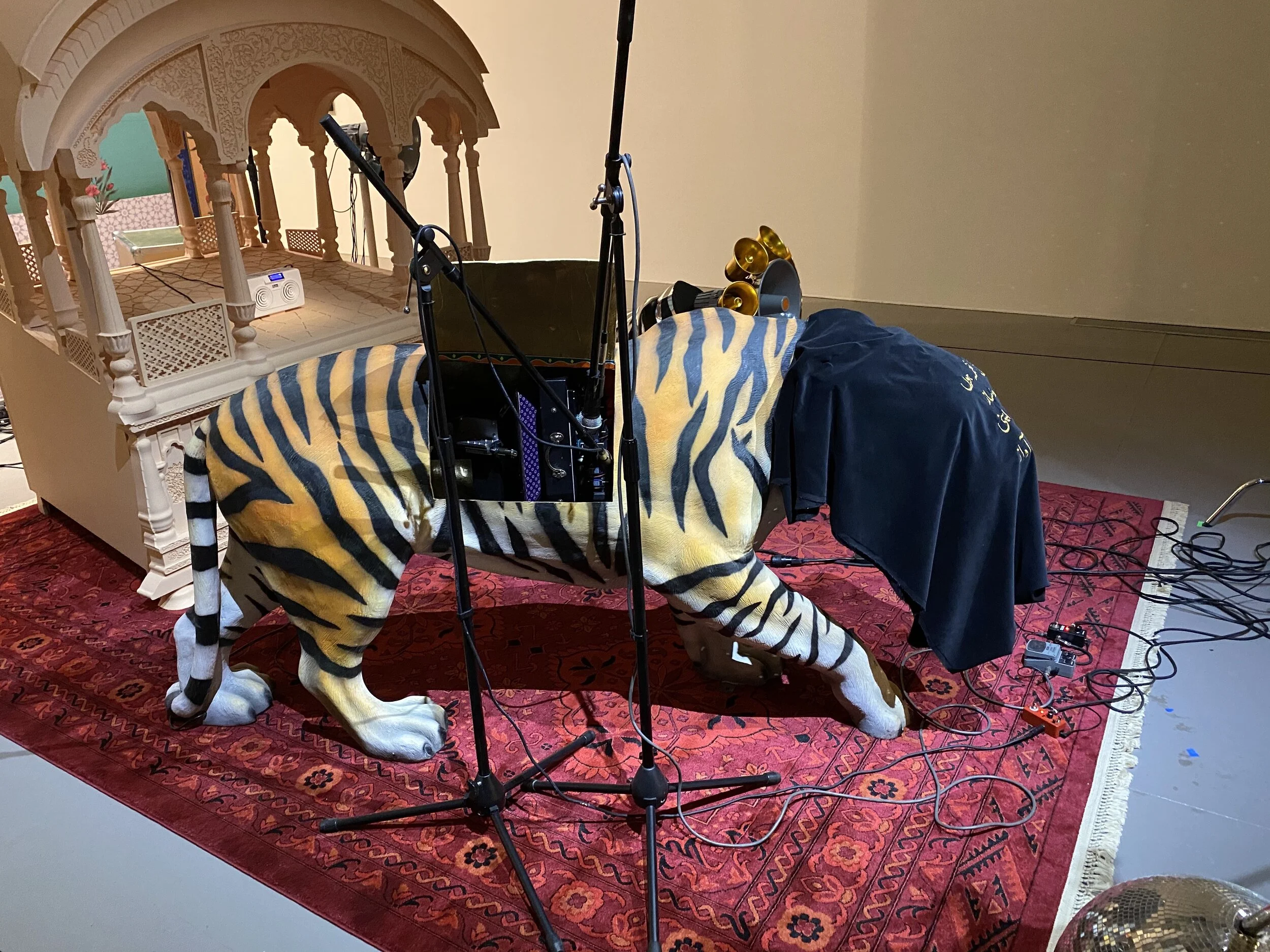
The sounds weight in anticipation of their song, hum tum tanana nana, nana nana ray
2020
The sounds weight in anticipation of their song, hum tum tanana nana, nana nana ray, (1) is a sound installation that interprets the sounds and iconographies of South Asia through a decolonial position and contemporary lens.
The installation takes its formal inspiration from Mughal miniature paintings of the extravagant throne commissioned by Shah Jahan. The throne was encrusted in gems and decorated in ornate enamel and inscriptions—colloquially known as the “Peacock Throne” because of the two jeweled peacocks, perched atop its canopy (2). The Peacock Throne was the seat of Mughal emperors for a century before being looted by the British during their colonial occupation of India.
The installation reclaims this symbol of power, offering a royal staging for
the subversive electronic dance music emitted from the speakers. The music compositions puns on the power dynamics implicit in the use of “master” and “slave” in electronic networked systems and in electronic music (here through MIDI), wherein one device (here, the “master,” is an electronic Tabla, the MIDI-enabled Taalmala Digi-108 by the Radel Electronics Pvt. Ltd. an Indian electronic music maker, placed on the throne) controls the parameters of ‘slave’ devices on the network (here, controlling and dictating the rhythm and notes of the various ‘slaved‘ electronic drum machines and synthesizers via MIDI. These are housed in a rack case behind the throne). The seemingly ‘western’ sounding techno music playing is actually rooted and based on Indian rāga and taals (rather than derived from the Western compositional traditions). The sound element of the installation, staying true to the tradition of rāga, in which compositions have particular associations with time, season, and mood, activates only at particular, pre-appointed times of the day. These compositions are modified for particular installation settings. In this instance, two separate compositions of around 20-25 min are played each morning and afternoon, with some parametric deviation allowing for some improvisational variations occurring with each performance.
Each composition starts with a prelude played on the instrumental tiger. The tiger instrument is embedded with a custom MIDI-controlled electro-mechanical enabled Shruti drone box in its chest cavity. The musical tiger is a reference to Tipu’s Tiger (3), an 18th-century musical automaton. Here the bravado found in the original (the tiger an emblem for Tipu Sultan is depicted eating a British soldier) is replaced with a tiger’s head is veiled under a velvet drape (4) engraved in the original Urdu with a line from a poem from the 19th-century poet Mirza Ghalib, lamenting “ I am neither the flower/rose of sound/melody nor the tone of a [musical] harmony, I am the sound of my own breaking (translated)”, a reflection on the colonial and contemporary histories that expropriated and humiliated a community and one the work hopes to reframe and reclaim through its following subversive composition.
When not performing its performative ‘raags’, the installation continuously plays various tanpura drones through the two stylized flower speakers (the stalk and tiger), inspired by the many floral and animal motifs found in Mughal imagery.
An automated accompanying light show (via DMX protocols) follows the sequence of compositional events, turning off the house lights, spotlighting the tiger before proceeding to an accompanying disco light show for the main compositional sequence.
Providing the occasional anticolonial dance party, The sounds weight in anticipation of their song, hum tum tanana nana, nana nana ray.
The installation takes its formal inspiration from Mughal miniature paintings of the extravagant throne commissioned by Shah Jahan. The throne was encrusted in gems and decorated in ornate enamel and inscriptions—colloquially known as the “Peacock Throne” because of the two jeweled peacocks, perched atop its canopy. The Peacock Throne was the seat of Mughal emperors for a century before being looted by the British during their colonial occupation of India. The installation reclaims this symbol of power, offering a royal staging for the subversive electronic dance music emitted from the speakers. The music compositions puns on the power dynamics implicit in the use of “master” and “slave” in electronic programming and music (here through MIDI), wherein one device (the “master,” an electronic Tabla placed on the throne) controls the parameters of ‘slave’ devices on the network (dictating the rhythm and notes of the various ‘slave‘ drum machines and synthesizers). Such that the seemingly ‘western’ sounding techno music playing is actually rooted and based on Indian rāga and taals (rather than derived from the Western traditions). The sound element of the installation, staying true to the tradition of rāga, in which compositions have particular associations with time, season, and mood, activates only at particular, pre-appointed times of day—providing an occasional anticolonial dance party.
Material: Polyurethane foam, wood, fiberglass, taxidermy peacocks, PA speakers, microphones, guitar amp, effects pedals, mixer, speakers, Shruti box, Radel Taalmala Digi-108, Boss DR-202 Dr. Groove, Korg Monologue, Korg Volca FM, Korg Volca Key, Moog Minitaur, Behringer Model D, vinyl, rugs, par lights, led bar lights, dmx controller, computer, custom software, custom electronics, c-stands, mirror ball
Dimensions: Variable
(1) The misspelling of weight is purposeful. The phrase hum tum tanana nana, nana nana ray is taken from a poem, Man Kunto Maaula by Amir Khusro, often credited as being the inventor of the Tabla. The lines are Tarana bols, which are meaningless and are chants of the sufi saints, the poem is often sung as a qawali.
(2) The miniature paintings (all depicting the throne from the front) and a few written descriptions are all that remains of the throne. In the installation the throne is depicted with only the front view realized - the other sides are left as blank abstractions an allusion to their lack of description. The peacocks having ‘flown’ the coop per say now are perched on the lighting rig framing the works and watching the performance unfold.
(3) Tipu’s Tiger or Tippu’s Tiger is an eighteenth-century automaton or mechanical toy created for Tipu Sultan, the ruler of the Kingdom of Mysore in India. The carved and painted wood casing represents a tiger savaging a near life-size European man. Mechanisms inside the tiger and man’s bodies make one hand of the man move, emit a wailing sound from his mouth and grunts from the tiger. In addition a flap on the side on the tiger folds down to reveal the keyboard of a small pipe organ with 18 notes.
(4) Allusion to the humiliation of Muslim prisoners at Abu Ghraib and Guantanamo Bay is also inferred in by the veiled tiger’s depiction (orange jumpsuits and black hoods)



